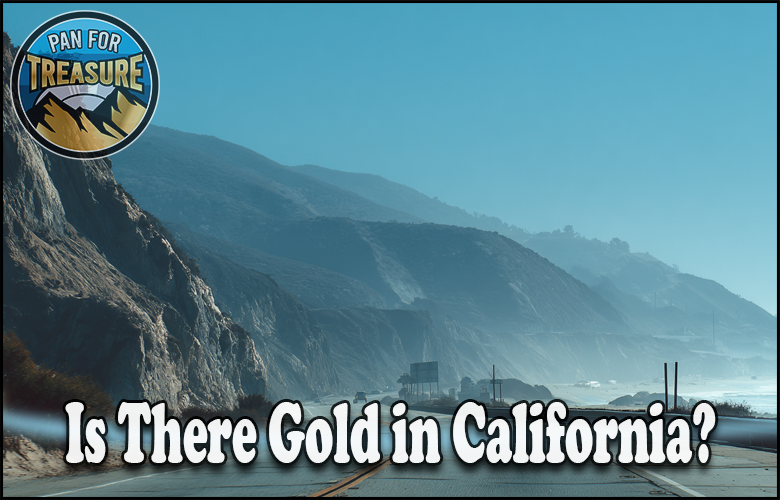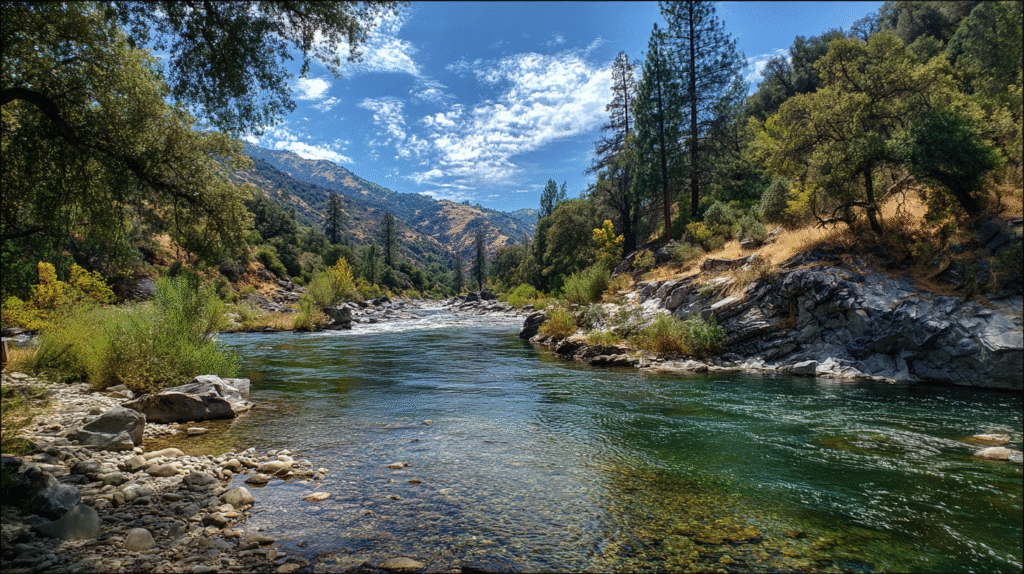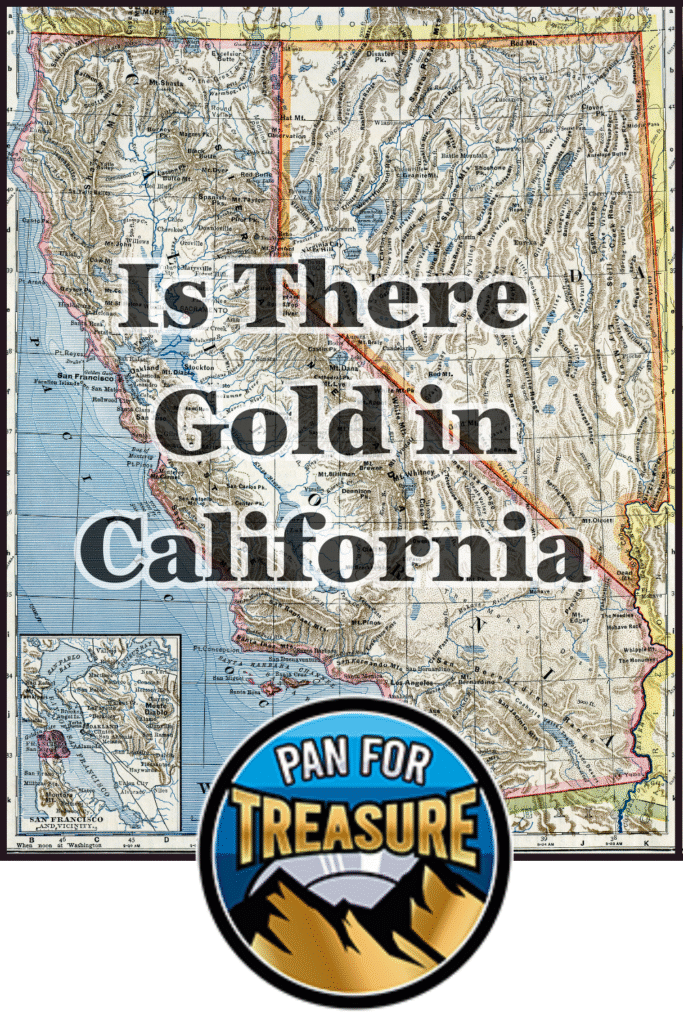
Disclosure: This Post Contains Affiliate Links; We earn a commission on purchases.
Is there gold in California? This question has fascinated adventurers and prospectors for generations, ever since the famous California Gold Rush of the 19th century transformed the state into a global symbol of opportunity and wealth.
While the frenzy of the gold rush has long passed, California’s rivers, streams, and gold-bearing landscapes continue to draw modern-day treasure hunters eager to uncover remnants of its glittering past.
From the rugged Sierra Nevada mountains to historic mining towns, California’s rich geology and storied history make it a captivating destination for anyone chasing the dream of striking gold.
Key Takeaways:
- The California gold rush of the 19th century brought people from all over the world to seek their fortunes.
- Geological forces over millions of years concentrated gold in California’s mountains.
- The gold rush led to the development of mining techniques that forever changed the state’s landscape.
- Recreational gold mining is still possible in California today.
- Historic sites offer the opportunity to connect with the state’s rich mining history and try your luck at finding gold.
Is there Gold in California?
Gold is abundant in California and has played a pivotal role in the state’s history, economy, and development.
From James Marshall’s discovery at Sutter’s Mill to the bustling gold production in Grass Valley and Nevada County, the allure of gold attracted countless gold seekers, including the legendary Forty-Niners, who transformed the United States during the California Gold Rush.
Placer mining along the Kern River, South Fork, and in the Klamath Mountains, as well as operations in Sierra County, contributed significantly to the state’s economy.
Cities like San Francisco, Los Angeles, and the Bay Area flourished as hubs for trade and commerce, while the U.S. Geological Survey and SD Bullion documented the impact of fluctuating gold prices on North America’s economy.
California’s rich gold deposits can be attributed to the fascinating geology of the region. Over hundreds of millions of years, the widely dispersed gold in the Earth’s crust became concentrated in what is now known as the gold-bearing regions of California.
Subsea Volcanoes and Gold-Bearing Magma: Ancient subsea volcanoes played a crucial role in the formation of gold deposits in California.
These volcanoes erupted, depositing lava and minerals, including gold, onto the sea floor. Over time, these deposits created islands and contributed to the concentration of gold.
“As the hot magma cooled, gold became concentrated within hydrous silica solutions and deposited within quartz veins.”
Formation of the Sierra Nevada: Geological movements forced the sea floor and volcanic deposits eastwards, leading to a collision with the North American plate.
This collision resulted in the uplift and formation of the granite rock that can be found in the Sierra Nevada and other mountain ranges in California today.
“The mountains of California rose and shifted several times, causing old river channels to move and deposit gold in ancient gravel beds.”
Quartz Veins and Erosion: Rich in gold, the cooled magma became concentrated within quartz veins. As the mountains of California rose and shifted, ancient river channels moved, spreading gold in the form of ancient gravel beds.
Erosion further concentrated the gold within these gravel beds, creating highly desirable deposits.
| Stages | Geological Processes | Result |
|---|---|---|
| 1 | Subsea volcanic activity | Lava and gold-bearing magma deposited onto the sea floor |
| 2 | Geological movements | Collision of volcanic deposits with the North American plate, forming the Sierra Nevada and other mountain ranges |
| 3 | Mountain uplift and shifting | Movement of ancient river channels, depositing gold in ancient gravel beds |
| 4 | Erosion | Concentration of gold within the ancient gravel beds |
The unique geology of California, with its gold-bearing magma, quartz veins, and the effect of erosion on ancient gravel beds, has given rise to the rich gold deposits that have captivated miners and enthusiasts for centuries.
Methods of Gold Recovery
During the California gold rush, early miners used a variety of techniques to recover gold from rivers and streams.
As the demand for gold increased, more sophisticated methods were employed to process larger volumes of gravel and extract gold from quartz veins. However, these methods also had negative environmental impacts.
1 – Placer Mining:
Early miners used simple techniques like panning to separate gold from gravel in rivers and streams. They later developed more efficient methods such as using cradles, rockers, and long-toms to process larger amounts of gravel. In the technique known as “coyoteing,” miners dug deep shafts to access the richest veins of pay dirt.
2 – Hydraulic Mining:
In the mid-1880s, hydraulic mining became popular. This method involved directing high-pressure water jets to wash away hillsides and expose gold-bearing gravel. It was estimated that around 12 million ounces of gold were removed during the first five years of the gold rush, and 11 million ounces were recovered through hydraulic mining.
3 – Hard-Rock Mining:
Hard-rock mining involved extracting gold directly from quartz veins through digging, blasting, and crushing. This method required more specialized equipment and higher levels of expertise. Between the 1860s and the turn of the century, prospectors found gold in various locations in California through hard-rock mining.
4 – Dredging:
Later in the gold rush, dredging became a common method of gold recovery. Large floating machines called dredges were used to extract gold-bearing gravel from riverbeds. The gravel was then processed on board to separate the gold.
While these methods allowed miners to recover substantial amounts of gold, they also had significant environmental impacts. Gravel and heavy metal pollution in streams, disruption of native habitats, and changes in the water quality were some of the consequences of gold mining in California.
The Legacy of the California Gold Rush
The discovery of gold in California had a significant impact on the state’s development. The gold rush attracted people from all over the world, causing the population to skyrocket from about 14,000 to nearly 100,000 by the end of 1849. By 1852, the population reached around 250,000. The rapid influx of settlers led to the establishment of cities and the growth of infrastructure. Sacramento, in particular, became a major supply center, sending goods to the mining towns in the Mother Lode region.
However, the mining activities also had negative environmental effects, including changes in water quality, disturbance of native sacred sites, and the destruction of agricultural land.
| Impact of the Gold Rush | Details |
|---|---|
| Population Growth | The gold rush attracted people from all over the world, leading to a rapid increase in population. |
| Immigration | People from various countries came to California in search of gold, leading to a diverse immigrant population. |
| Economic Boom | The gold rush boosted the economy of California, creating jobs and opportunities for businesses. |
| Cities | New cities and towns were established to accommodate the growing population and provide services to miners. |
| Infrastructure | Roads, bridges, and other infrastructure projects were developed to support mining operations and connect different regions. |
| Environmental Effects | Mining activities resulted in changes to water quality, damage to sacred sites, and destruction of agricultural land. |
The legacy of the California gold rush can still be seen today in the historic cities, cultural diversity, and economic prosperity of the state.
The impact of the gold rush on California’s development is a testament to the profound influence of this historical event.
Modern-day Gold Mining in California
While most of the gold in California was discovered during the gold rush, there are still opportunities for modern-day recreational gold mining. Many locals from the Sacramento area and other parts of California engage in recreational gold mining as a hobby. They enjoy the thrill of searching for gold and the satisfaction of finding precious flakes and nuggets.
California is home to numerous historic sites where gold mining played a significant role in shaping the state’s history. These sites not only offer a glimpse into the past but also provide opportunities for recreational miners to try their luck. Some notable historic sites for gold mining include:
- Marshall Gold Discovery State Historic Park: This park is located in Coloma, where the California gold rush first began in 1848. Visitors can pan for gold along the American River and learn about the history of the gold rush.
- Auburn State Recreational Area: Situated along the scenic American River, this area offers gold panning as well as various outdoor activities such as hiking, camping, and fishing.
- South Yuba River State Park: This park is known for its stunning natural beauty and rich gold mining history. Visitors can explore the park’s historic mining sites and try their luck at gold panning.
For those looking to connect with other gold enthusiasts, joining a prospecting club can be a great way to learn from experienced miners and share the excitement of the hunt.
One such club in California is the River City Prospectors GPAA, which organizes outings, provides educational resources, and fosters a sense of community among its members.
Gold Panning Regulations in California
Before engaging in recreational gold mining in California, it is essential to familiarize yourself with the gold panning regulations and environmental laws.
While recreational mining is generally allowed in many rivers and streams, there are certain restrictions and guidelines in place to protect the environment and preserve historical sites.
Here are some key regulations to keep in mind:
- Obtain the necessary permits or permissions if required by local authorities or private landowners.
- Use only hand tools such as pans, small shovels, and sluice boxes. Motorized equipment is not allowed in many areas.
- Respect the environment and leave no trace. Fill in any holes you dig and dispose of waste properly.
- Do not disturb or remove artifacts or historical structures at historic mining sites.
By adhering to these regulations and practicing responsible mining techniques, recreational miners can enjoy the thrill of searching for gold while preserving California’s natural and historical treasures.
Other Gold Mining Areas in California
In addition to the Mother Lode region, there are other areas in California where gold deposits were discovered. Let’s explore some of these fascinating locations:
Klamath Gold Fields
The Klamath Mountains in northwest California are rich in gold history. The historic town of Shasta, nestled in the heart of the Klamath gold fields, takes us back to the days of the Klamath gold rush. Immerse yourself in the remnants of this vibrant era by visiting the Weaverville Joss House State Historic Park, where you can experience the authentic atmosphere of a bygone gold mining community.
Bodie State Historic Park
Located in the eastern Sierra Nevada, Bodie State Historic Park preserves the remains of what was once a thriving gold mining town. Step back in time and explore the deserted streets, buildings, and artifacts that tell the story of Bodie’s golden past. This well-preserved ghost town offers a fascinating insight into the hardships and triumphs of the gold rush era.
Cuyamaca Rancho State Park
Southern California is not to be overlooked in the gold mining history of the state. Cuyamaca Rancho State Park holds the Stonewall Mine, which played a significant role in producing gold in the late 1800s. Take a journey through time and discover the remnants of this once-thriving mine. Learn about the challenges faced by miners and the impact of gold on the region’s development.
Picacho State Recreation Area
Traveling to the lower Colorado River, the Picacho State Recreation Area offers a glimpse into the remnants of the Picacho gold mining community. Explore the historical artifacts and structures that showcase the ingenuity and perseverance of the miners who sought their fortunes in this rugged landscape. The allure of gold is still evident in this picturesque recreational area.
These lesser-known gold mining areas in California provide unique opportunities to immerse yourself in the rich history and legacy of the state’s gold rush era. Discover the stories, explore the remains, and connect with the adventurous spirits who left their mark on these remarkable locations.
| Gold Mining Area | Location | Historical Significance |
|---|---|---|
| Klamath Gold Fields | Northwest California | Home to the historic town of Shasta and the Weaverville Joss House State Historic Park, recalling the days of the Klamath gold rush. |
| Bodie State Historic Park | Eastern Sierra Nevada | Preserves the remains of a once-thriving gold mining town, offering a glimpse into the challenges and triumphs of the gold rush era. |
| Cuyamaca Rancho State Park | Southern California | Home to the Stonewall Mine, which played a significant role in gold production in the late 1800s and offers insights into the region’s mining history. |
| Picacho State Recreation Area | Lower Colorado River | Features the remnants of the Picacho gold mining community, showcasing the ingenuity and perseverance of early miners in a picturesque location. |

Gold Panning FAQs for California
Is there gold in California rivers?
Yes, California is world-famous for gold-rich rivers like the American River, Feather River, and Yuba River. These rivers were central to the 1849 Gold Rush and still produce gold today for recreational panners.
Is there gold in California creeks?
Absolutely. Countless creeks throughout the Sierra Nevada foothills contain placer gold. Woods Creek, Deer Creek, and Greenhorn Creek are just a few known spots where prospectors continue to pan for gold.
Is there gold in California streams?
Yes, many streams in gold-bearing regions of California still carry fine gold. Gravel bars, exposed bedrock, and inside bends are often the most productive locations for recovery.
Is there gold in California today?
Recreational gold prospecting remains popular in California. With the right tools and location, panners still find gold flakes and small nuggets in the state’s rivers and streams.
Where can I pan for gold in California?
Top sites include Marshall Gold Discovery State Historic Park in Coloma, South Yuba River State Park, and designated areas in the Eldorado and Stanislaus National Forests. Always follow local prospecting rules and land-use guidelines.
{
“@context”: “https://schema.org”,
“@type”: “FAQPage”,
“mainEntity”: [
{
“@type”: “Question”,
“name”: “Is there gold in California rivers?”,
“acceptedAnswer”: {
“@type”: “Answer”,
“text”: “Yes. California is world-famous for gold-rich rivers like the American River, Feather River, and Yuba River. These rivers were central to the 1849 Gold Rush and still produce gold today for recreational panners.”
}
},
{
“@type”: “Question”,
“name”: “Is there gold in California creeks?”,
“acceptedAnswer”: {
“@type”: “Answer”,
“text”: “Yes. Many creeks throughout the Sierra Nevada foothills contain placer gold. Woods Creek, Deer Creek, and Greenhorn Creek are well-known spots where prospectors still pan for gold.”
}
},
{
“@type”: “Question”,
“name”: “Is there gold in California streams?”,
“acceptedAnswer”: {
“@type”: “Answer”,
“text”: “Yes. Streams in gold-bearing regions still carry fine gold. Gravel bars, exposed bedrock, and inside bends are often the most productive locations.”
}
},
{
“@type”: “Question”,
“name”: “Is there gold in California today?”,
“acceptedAnswer”: {
“@type”: “Answer”,
“text”: “Yes. Recreational gold prospecting remains popular across California, and panners continue to find flakes and small nuggets in rivers and streams.”
}
},
{
“@type”: “Question”,
“name”: “Where can I pan for gold in California?”,
“acceptedAnswer”: {
“@type”: “Answer”,
“text”: “Top sites include Marshall Gold Discovery State Historic Park in Coloma, South Yuba River State Park, and designated areas in the Eldorado and Stanislaus National Forests. Always follow local prospecting rules and land-use guidelines.”
}
}
]
}
Conclusion
The gold mining history of California is deeply rooted in the state’s identity, leaving a lasting legacy that continues to capture the imagination of people today.
While the gold rush of the 19th century brought thousands of fortune seekers to the region, the allure of finding gold remains strong, even though the available deposits have largely been exhausted.
Despite the majority of gold already being discovered, there are still opportunities for recreational gold mining in California’s rivers and streams.
The state’s unique geology, shaped by ancient volcanoes, tectonic movements, and erosion, has contributed to the concentration of gold within its mountains and riverbeds.
By preserving the historic mining sites and embracing the state’s rich mining history, individuals can connect with the past and gain a deeper appreciation for California’s gold mining heritage.
Whether it’s the thrill of hunting for precious metals or the fascination with the state’s rich history, the California gold rush still captivates and inspires modern-day prospectors to ask, “Is there gold in California?”
Source Links
- https://en.wikipedia.org/wiki/Gold_in_California
- https://www.parks.ca.gov/?page_id=1081
- https://www.sacbee.com/news/bee-curious/article259075693.html


Meet Ryan Conlon, the passionate owner and driving force behind Pan for Treasure.
With an unwavering love for the art of gold panning, Ryan has transformed his enthusiasm into a thriving community hub for fellow treasure seekers. [email protected]
A seasoned gold panning enthusiast, Ryan’s journey began with a simple pan and a dream, evolving into a deep appreciation for the history, geology, and thrill of uncovering precious metals.
Subscribe to Our Newsletter
